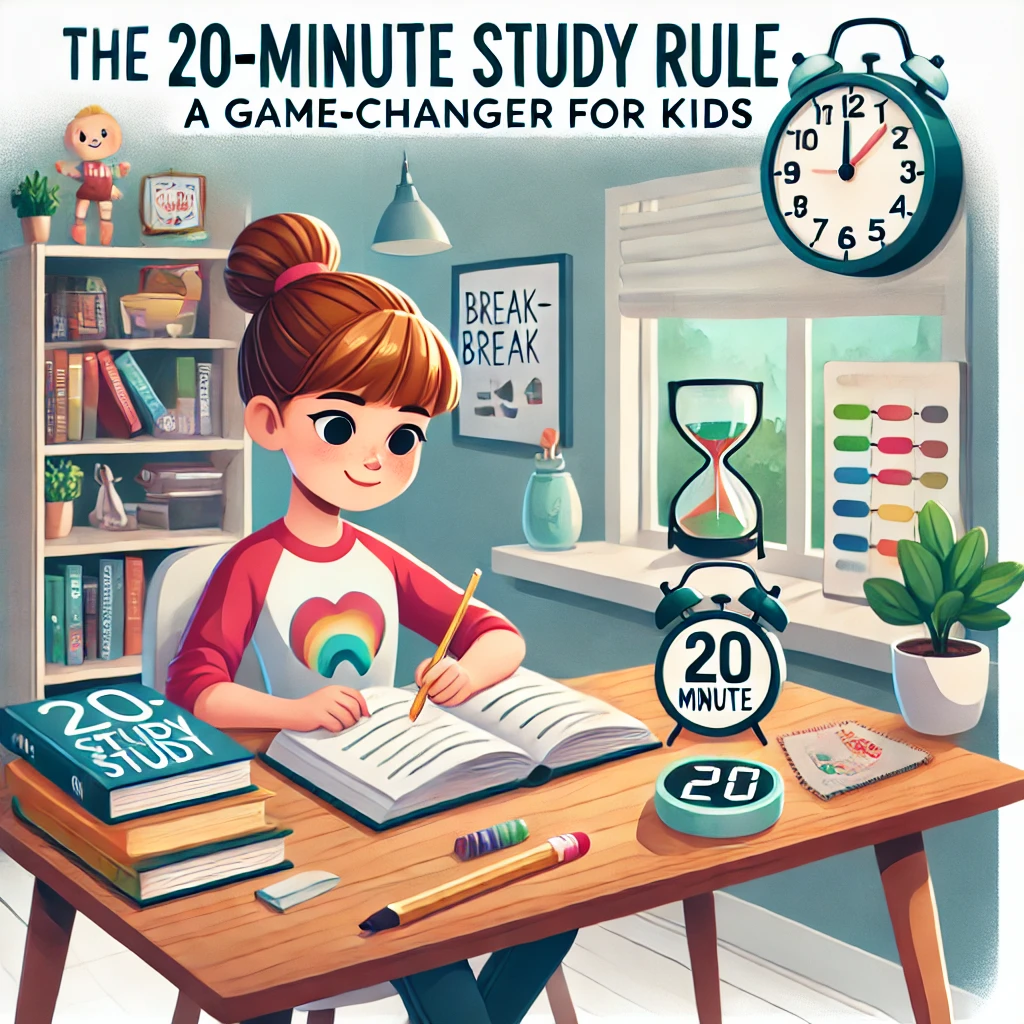Studying for long hours can be tiring and boring for kids. Many children struggle with concentration and memory retention when they are forced to sit for extended study sessions. The 20-minute study rule is a simple yet highly effective method that helps children learn better by studying in short, focused intervals. By following this technique, kids can stay engaged, reduce stress, and improve their ability to retain information for longer periods. It also promotes a structured study habit that is easy to follow and enjoyable.
What is the 20-Minute Study Rule?
The 20-minute study rule means studying for 20 minutes and then taking a short break before continuing the next session. This method is inspired by the Pomodoro Technique, which is widely used by students and professionals to enhance concentration and productivity. The principle behind this approach is simple—our brains learn and remember information better when we study in short, focused intervals instead of prolonged, exhausting sessions.
Shorter study periods prevent mental fatigue, and breaks allow the brain to process information efficiently. By using this technique, children can remain engaged in their studies without feeling overwhelmed. This strategy is particularly useful for young learners, as their attention spans are naturally shorter.
Why Does the 20-Minute Study Rule Work?
- Helps Kids Focus: Studying for short periods keeps kids alert and prevents distractions. When children know they only need to concentrate for 20 minutes, they are more likely to stay focused and attentive during that time.
- Prevents Tiredness: Studying in small chunks prevents mental exhaustion. Long study hours can lead to burnout, but regular breaks help children stay fresh and energized throughout the session, making learning more efficient.
- Improves Memory: The brain retains information better when learning happens in intervals. Frequent breaks allow the brain to process and store knowledge effectively, leading to better long-term retention and recall.
How to Use the 20-Minute Study Rule
1. Set a Timer for 20 Minutes
Children should study with full concentration for 20 minutes without any interruptions. Using a timer helps them stay accountable and focused without feeling overwhelmed. This also trains them to develop self-discipline and awareness of time management.
2. Take a 5-Minute Break
After each study session, kids should take a short 5-minute break. Activities like stretching, drinking water, or deep breathing help refresh their minds. This short rest prevents fatigue and makes the next session more productive.
3. Repeat the Cycle
After the break, restart another 20-minute study session. Repeating this cycle 3-4 times ensures an effective study routine without causing mental strain. This method allows kids to complete their tasks efficiently while staying engaged in the learning process.
4. Remove Distractions
To ensure focused learning, all distractions like mobile phones, TV, and loud noises should be avoided. A quiet and comfortable study space enhances concentration and helps children stay on task. Parents can assist by creating a distraction-free environment at home.
5. Use Active Learning
Kids should engage in interactive learning techniques like taking notes, making mind maps, or explaining topics aloud. Instead of passively reading textbooks, active learning encourages better understanding and long-term retention of information.
Benefits of the 20-Minute Study Rule
1. Increases Productivity
Short study sessions help children absorb information efficiently. This method maximizes learning in less time, making studying more productive and reducing wasted time spent on distractions.
2. Makes Studying Fun
Studying in smaller intervals feels less stressful and more engaging. Kids enjoy learning when they know they won’t have to sit for long hours without breaks. The structured approach makes learning an enjoyable habit rather than a chore.
3. Builds a Study Habit
Following this technique daily creates a structured routine. It encourages discipline and consistency in a child’s academic life, leading to improved performance in school and a lifelong habit of efficient studying.
4. Reduces Stress
Breaking studies into manageable parts lowers anxiety. Kids feel more confident when they know they won’t have to study for hours at a time. This approach makes learning more enjoyable and less intimidating for students who may otherwise struggle with long study sessions.
5. Teaches Time Management
Children learn to manage their time efficiently. Completing tasks within short periods prepares them for better self-discipline and organization. This habit helps not only in academics but also in everyday life and future professional settings.
How This Rule Helps Kids
Many children have improved their learning by using the 20-minute study rule. Parents report that their kids complete homework faster, retain lessons better, and enjoy studying more when following this approach. Teachers and tutors also find this method useful in keeping students engaged and attentive in class.
This technique is particularly effective for children who struggle with attention issues or who find long study sessions overwhelming. By breaking tasks into smaller, manageable parts, students feel a sense of accomplishment with each completed session, keeping them motivated to continue learning.
Conclusion
The 20-minute study rule is an easy yet powerful way to help kids study better. It makes learning fun, keeps children focused, and improves memory retention. This method encourages a disciplined approach to studying while reducing the mental strain that often comes with long study hours.
Parents and teachers can use this strategy to help kids develop good study habits that will benefit them for life. Whether preparing for exams, completing assignments, or learning new skills, this technique can be a game-changer in a child’s academic journey.




